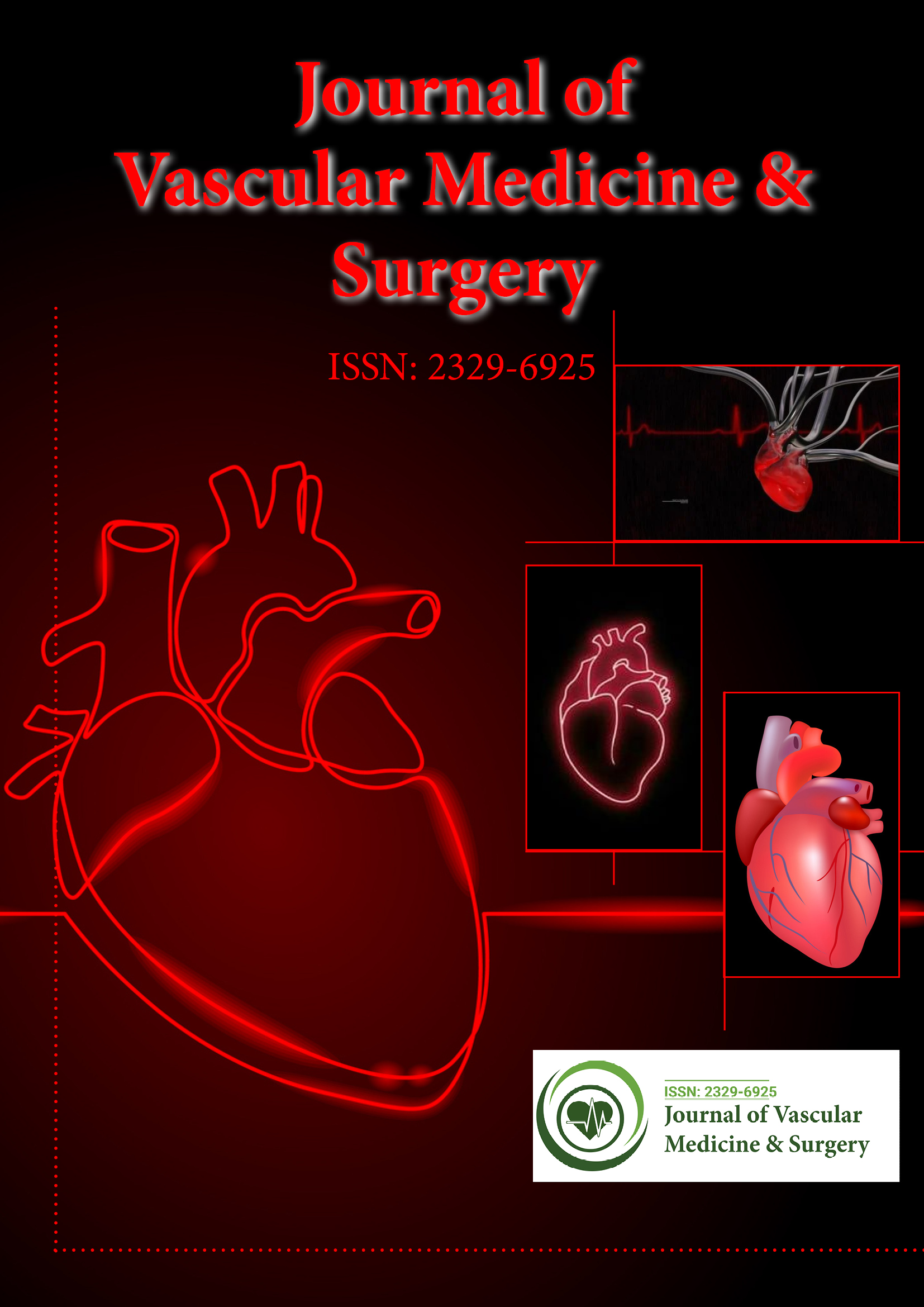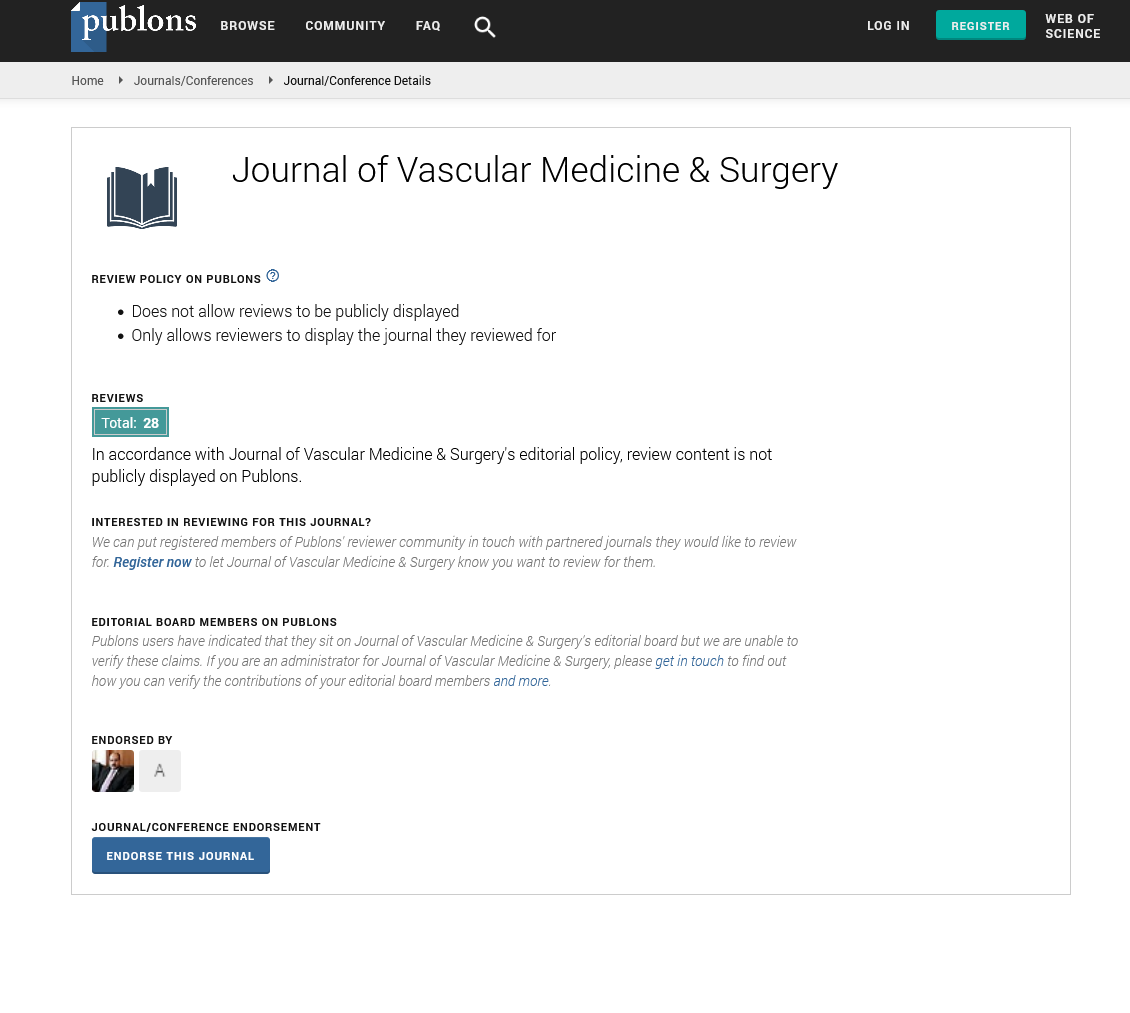Indexed In
- Open J Gate
- Academic Keys
- RefSeek
- Hamdard University
- EBSCO A-Z
- OCLC- WorldCat
- Publons
- Euro Pub
- Google Scholar
- SHERPA ROMEO
Useful Links
Share This Page
Journal Flyer

Open Access Journals
- Agri and Aquaculture
- Biochemistry
- Bioinformatics & Systems Biology
- Business & Management
- Chemistry
- Clinical Sciences
- Engineering
- Food & Nutrition
- General Science
- Genetics & Molecular Biology
- Immunology & Microbiology
- Medical Sciences
- Neuroscience & Psychology
- Nursing & Health Care
- Pharmaceutical Sciences
Opinion Article - (2025) Volume 13, Issue 8
Addressing Unmet Needs in Vascular Therapy Development
Yuanyun Hao*Received: 24-Jul-2025, Manuscript No. JVMS-25-29911; Editor assigned: 28-Jul-2025, Pre QC No. JVMS-25-29911 (PQ); Reviewed: 11-Aug-2025, QC No. JVMS-25-29911; Revised: 18-Aug-2025, Manuscript No. JVMS-25-29911 (R); Published: 25-Aug-2025, DOI: 10.35248/2329-6925.25.13.614
Description
Vascular diseases remain one of the leading causes of morbidity and mortality worldwide. Despite notable advancements in medical technology and pharmacology, many critical gaps persist in the development and delivery of effective vascular therapies. These unmet needs range from limited treatment options for complex conditions to disparities in access and innovation for specific patient populations. Addressing these challenges requires a holistic approach that integrates scientific innovation, patient-centered care, and systemic reform to ensure that progress in vascular medicine reaches every individual in need.
Gaps in innovation and clinical efficacy
While the vascular field has seen considerable progress—particularly with the rise of endovascular procedures, stenting technologies, and drug-eluting devices—many therapies still fall short in terms of durability, efficacy across diverse patient populations, and adaptability to complex disease presentations. Peripheral Artery Disease (PAD), for example, continues to pose a therapeutic challenge. While balloon angioplasty and stenting can temporarily restore blood flow, restenosis remains a persistent problem. The need for longer-lasting solutions that maintain vessel patency without triggering inflammation or thrombosis is a clear area of unmet need.
Similarly, in venous diseases such as chronic venous insufficiency or deep vein thrombosis, the limitations of current therapies become apparent when addressing long-term complications like post-thrombotic syndrome. Anticoagulation remains a mainstay of treatment, but it is not a cure, and its effectiveness can be influenced by patient adherence, bleeding risk, and comorbid conditions. There is a clear demand for therapies that not only manage symptoms but also actively promote vascular healing and restoration of function.
In many cases, current vascular therapies are designed with a “one-size-fits-all” approach, despite growing awareness that patient responses vary significantly due to factors such as age, sex, ethnicity, and comorbidities like diabetes or kidney disease. For instance, diabetic patients often present with more diffuse and distal arterial disease, which may not respond as well to standard revascularization techniques. The absence of targeted therapies for such subgroups highlights a critical shortcoming in vascular therapy development.
Another pressing issue is the absence of effective therapies for vascular aging. As the global population grows older, age-related vascular changes such as arterial stiffness and endothelial dysfunction become more prevalent and contribute significantly to cardiovascular risk. Yet, therapeutic options that specifically target the biological processes of vascular aging are still in early stages of development, despite their enormous potential impact on public health.
Barriers to access, equity, and personalized care
Beyond scientific and clinical limitations, structural and systemic challenges also play a major role in perpetuating unmet needs in vascular therapy. Access to high-quality vascular care remains unequal, particularly in rural and underserved regions. Advanced therapies, cutting-edge devices, and specialist expertise are often concentrated in urban centers or academic hospitals, creating geographical disparities in outcomes.
Cost is another major barrier. Many of the latest vascular innovations, including drug-coated balloons, bioresorbable stents, and hybrid imaging-guided procedures, come at a premium. In healthcare systems already strained by financial pressures, cost-effectiveness becomes a determining factor in whether new therapies are adopted. Unfortunately, this often means that patients who could benefit most from new solutions may not receive them due to insurance limitations, budget constraints, or lack of institutional support.
There is also an urgent need to integrate personalized medicine into vascular therapy development. As genetic and molecular profiling become more sophisticated, opportunities are emerging to identify biomarkers that predict how a patient will respond to certain therapies. However, such approaches are not yet widely implemented in vascular medicine. Unlike oncology or immunology, where personalized treatment protocols are rapidly becoming standard, vascular therapy still largely relies on population-based guidelines. Bridging this gap requires investment not just in research, but also in clinical infrastructure capable of interpreting and acting on individualized data.
Patient engagement is another overlooked aspect. Successful vascular therapy depends not only on technical efficacy but also on patient adherence, understanding, and participation in care. Many patients with chronic vascular conditions struggle to adhere to complex medication regimens, lifestyle modifications, or follow-up schedules. Therapies that are easier to use, require less intensive monitoring, or are designed with the patient’s lived experience in mind can significantly improve outcomes. Yet, patient-centric design remains a secondary consideration in many therapy development pipelines.
Finally, clinical trials—essential for bringing new therapies to market—often lack diversity in enrollment. This leads to data that may not accurately reflect real-world patient populations, particularly in terms of racial, ethnic, and gender differences. Expanding trial representation is not only a matter of equity but also a scientific necessity. Vascular diseases do not affect all groups equally, and therapies must be evaluated in the populations they are intended to serve.
Conclusion
In conclusion, addressing the unmet needs in vascular therapy development is a multifaceted challenge that goes beyond inventing the next big device or drug. It requires a fundamental shift in how innovation is pursued prioritizing durability, personalization, and inclusivity. It demands that therapies be designed with real-world patients in mind, not just ideal trial conditions. And most importantly, it calls for a commitment to equity, ensuring that all patients regardless of background, location, or condition have access to the benefits of modern vascular medicine. Only by addressing these gaps can we truly improve the lives of those living with vascular disease and meet the evolving demands of global healthcare.
Citation: Hao Y (2025). Addressing Unmet Needs in Vascular Therapy Development. J Vasc Surg. 13:614.
Copyright: © 2025 Hao Y. This is an open-access article distributed under the terms of the Creative Commons Attribution License, which permits unrestricted use, distribution and reproduction in any medium, provided the original author and source are credited.

